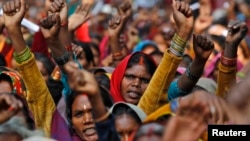Megacities of the future will boast high-speed rail, superfast broadband, and green energy systems — but experts Thursday said they were failing to leave space for one thing: girls.
Proposed by leaders worldwide, so-called Smart Cities are being built to cater for a growing global middle class but risk leaving girls without safe areas to learn and play, according to a panel of experts.
"I looked at all the traditional reports on inclusive cities, resilient cities, smart cities, sustainable cities. Please go through them in detail — there is no room for girls," said Manoj Kumar, head of Indian charity the Naandi Foundation.
"It's about: 'Will we have the subways, will we have the metros, will it run on biofuel.' ... But for whom? There is no discussion of what will be the habitat for girls," Kumar said at the Reuters' annual two-day Trust Conference, which focuses on slavery and women's rights issues.
In 2014, 54 percent of the population lived in cities but by 2050, this is expected to rise to 66 percent, according to the United Nations.
The number of megacities — which are home to more than 10 million people — has tripled since 1990 to 31, and U.N. Habitat predicts this will rise to 41 by 2030.
Experts from Egypt, India and Britain said the pace of urbanization could leave behind vulnerable girls and women.
Sheela Patel, director of The Society for the Promotion of Area Resource Centers, a charity that works with marginalized people living in slum housing, said the growing middle class was fueling the growth of cities which ignore the poorest.
"[The urban middle class] has a very large number of poor people who make our lives comfortable, but we keep them invisible," Patel said.
Girls in India often lack safe spaces and choose to stay at school after classes as they fear returning to crowded family houses where they feel vulnerable to harassment and attack, said Kumar of Naadi, which runs after-school clubs for girls.
India's "rampant" migration to cities from rural areas creates dangerous, crowded residential areas, which can put women in danger and limit their opportunities, Kumar added.
"Safety is at risk for girls and the biggest challenge they're facing is that the only way they are defined to be safe is by getting them married," he said.





